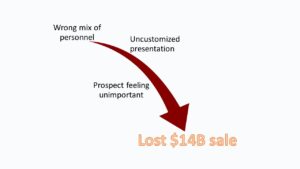


How much is one sales meeting worth to your business? Sports merchandise powerhouse Nike is finding out the hard way that not treating every pitch as significant can have major ramifications. In a recent ESPN article, reporter Ethan Strauss unveiled the story of the courtship for reigning NBA MVP Steph Curry by top sponsors Nike and Under Armour. Readers of the article learned cringe-worthy details of how the top sports brand in the world lost an athlete worth an estimated $14 billion to one of their top competitors. What readers might not have realized, however, is how prevalent the same mistakes that plagued Nike are in sales situations. Let’s take a closer look at how Nike turned off one of their most promising young stars, and violated several cardinal rules of sales.
In 2013, Nike met with Curry, who was a current client at the time, in order to sign him to a contract extension. Instead of bringing their top brass, however, Nike chose not to include one of their chief athlete advisors, suggesting to Curry that Nike did not feel he was important or relevant enough to warrant the additional attention. As Anova has learned through thousands of Win / Loss interviews, having the right personnel at sales presentations is absolutely critical to making prospects (and in this case existing clients) feel important and valued. Not having their top personnel at the meeting was a bad first step, but pales in comparison to the rookie mistakes made by the Nike officials that were present.
The Nike presentation was also lacking in customization. Included within was a slide with Kevin Durant’s name instead of Curry’s, indicating the PowerPoint shown to Curry was merely a reprocessed presentation of one given to another Nike athlete. To add insult to injury, one Nike official was said to have mispronounced Stephen’s name. Between the recycled PowerPoint and calling Curry by the wrong name, Nike failed to make their client feel valued. The inability to make a client (or potential client) feel important is consistently one of the top sales weaknesses cited by respondents in Win / Loss surveys. In this case, it cost Nike considerably.
Unfortunately, unprepared sales teams and uncustomized presentations cost businesses hundreds of thousands of dollars in potential revenue annually. In 2015 alone, Anova identified ineffective sales performance as a reason for losing bids in almost 50% of all situations!
The real question is: can your organization afford to NOT be more prepared than Nike was?
 Note: This is the third perspective piece on the different ways to analyze client satisfaction data. Previous posts focused on Overall Satisfaction Ratings and At Risk Accounts.
Note: This is the third perspective piece on the different ways to analyze client satisfaction data. Previous posts focused on Overall Satisfaction Ratings and At Risk Accounts.
One of the biggest drivers of satisfaction is the experience clients have with the personnel they interact with. Think about it: aggravations with products or qualms over pricing can be remedied by having someone you feel good about interacting with, someone who listens to your problems and tries to solve them. Organizations devote extensive resources to making sure the personnel that interact with their clients are professional, knowledgeable, and likeable. As such, gathering scores rating service team members is an important part of client satisfaction research.
Asking open-ended questions about the personnel can be very useful. It is important to give your clients the platform to openly share their opinions of what their service team is doing well or could improve on. It is also important to gather quantitative ratings on relevant attributes of the service personnel. When analyzed, scores for areas such as responsiveness, consultative approach, and quality of interactions can identify areas your team could improve their skillset.
After gathering a myriad of ratings for an individual team member, calculate the average for each attribute and see which areas someone may need additional training. A Relationship Manager may have high ratings for problem resolution skills and responsiveness, but lower scores for proactive approach. Consider ways to help that individual find their voice and reach out to clients without prompting (this can range from a simple “checking in to see how things are going” email to providing value-add content such as an invite to a relevant webinar).
In Year 1 of gathering ratings, make it clear that these initial results are a baseline, and track how service team members’ scores trend over time. When scores are improving, praise the personnel for realizing their weak points and improving them. If scores are trending downward, be sure to provide training and resources to your employee on how they can reverse that trend.
The baseline is not just relevant for day-to-day contacts but also management. For example, a new executive such as a Head of Service or COO should note the satisfaction scores in the first year of her new role, and track how the overall rating trends over the course of her tenure. Super users of client satisfaction research also tie in performance reviews and compensation to the year-over-year results of their study.
Scores should not be used as part of a witch hunt or to single out employees, but rather to identify areas where additional training can be provided to your employees. In the best situations, Anova’s clients are eager to receive their ratings each year, particularly looking to see if the areas they have been focused on with their customers are translating to improved scores. If the ratings are incorporated in a positive manner into your company’s culture, they can be used as a springboard for positive improvement and development.
 The past four blogs have discussed the different reasons decision makers choose to buy products and services, and just one final area remains to be analyzed as part of this series. On the surface it seems obvious: the ability of the salesperson to convince the buyer to actually buy their product.
The past four blogs have discussed the different reasons decision makers choose to buy products and services, and just one final area remains to be analyzed as part of this series. On the surface it seems obvious: the ability of the salesperson to convince the buyer to actually buy their product.
First, it is important to define sales effort. In a typical win / loss program, feedback is garnered across a number of sales attributes such as the salesperson’s responsiveness and rapport building with the prospect, their ability to conduct needs analysis and customize the presentation to the prospect’s unique needs, and ultimately make the prospect feel like an important client.
After looking at thousands of Win Loss Analysis interviews from the past year, sales effort was noted as a reason for choice in 11% of Mature market and 17% of Emerging market decisions. These frequencies may seem low, but they emphasize just how important Win Loss Research is to understanding business choices.
17% was actually the second-highest percentage amongst reasons for choice in Growth markets, bringing to light how complex decisions in these industries can be. There is never a predictable answer that is standard across these deals, and although it is critical for sales teams in these markets to effectively articulate their company’s value proposition, according to the data shared with us, most of the time they fall short.
Now consider the Mature market, where sales effort was only noted by 11% of respondents. In the more commoditized spaces, the significance of sales effectiveness on winning a deal is intensified. Salespeople need to be able to differentiate from the rest of the market, but ultimately the 11% figure demonstrates their ability to do so is not very high.
If you remember that one-fifth of all decisions in Mature markets involve a previous relationship, not only are sales reps in these spaces selling against analogous competitors but also against strong incumbent ties. While these binds may be deflating the sales approach as a reason for choice number (because some prospects are averse to changing providers due to switching costs and pains, even if a competitor outsold them), they reemphasize how essential it is for sales reps to raise their game.
A win / loss program is an essential tool to understanding sales effectiveness because it arms executives and sales teams with the data, feedback, and suggestions needed to become more effective. In the past year, 75% of Anova’s clients did just that, improving the frequency in which sales was mentioned by prospects as a reason for choosing them in bids won situations compared to the rate in their previous program. Sales teams across all types of industries struggle with sales effectiveness, and this kind of research can give them a leg-up when trying to win more business.
This concludes the 5-part series investigating buying decisions across Mature and Growth markets. For a recap of past analysis, below are the links to the articles.